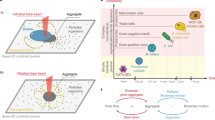Abstract
An idealization of chemical combination is formulated as a model of computability, and it is shown that this model has universal computational power just in case assembly has at least two-dimensional space in which to occur. It is also shown that this model, under reinterpretation, corresponds to a cellular automaton in which growth occurs by differentiation only (i.e., the state into which any cell is born is thereadfter fixed). Hence this latter model of growth is also computationally universal.
Similar content being viewed by others
Literature
Baer, R. M. 1973. “Computation by Assembly.”Technical Report No. 12, Computer Science Dept., University of California, Berkeley;J. Comp. Syst. Sci, to be published.
— and J. van Leeuwen, 1973. “The Halting Problem for Turing Assemblers.”Technical Report No. 23, Computer Science Dept., University of California, Berkeley.
— and H. Martinez. 1974. “Automata and Biology,” InAnnual Review of Biophysics and Bioengineering, Vol. 3, pp. 255–292.
Watson, J. D. 1970.Molecular Biology of the Gene. New York: W. A. Benjamin.
Author information
Authors and Affiliations
Rights and permissions
About this article
Cite this article
Baer, R.M. Self-assembly and differentiation as models of computability. Bltn Mathcal Biology 37, 59–69 (1975). https://doi.org/10.1007/BF02463492
Received:
Issue Date:
DOI: https://doi.org/10.1007/BF02463492




